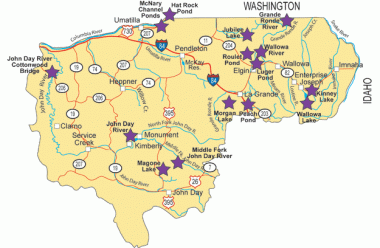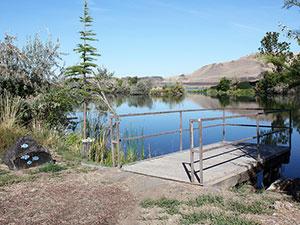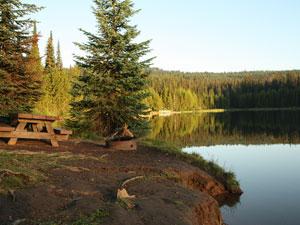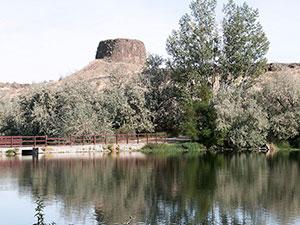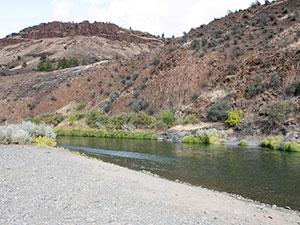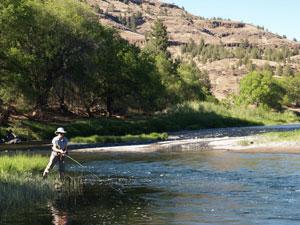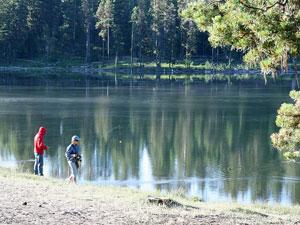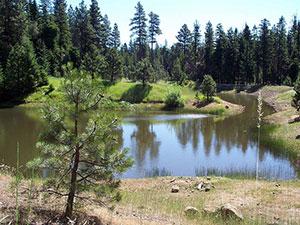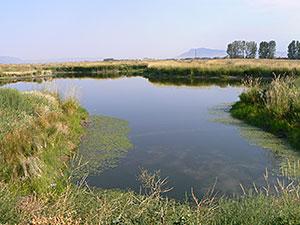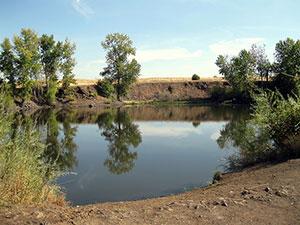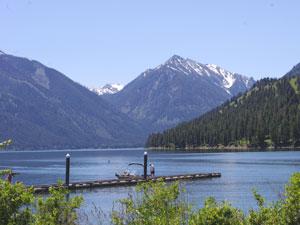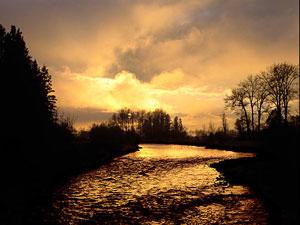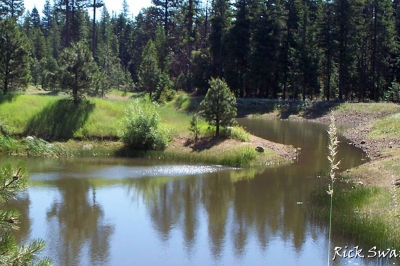
Easy angling in the Northeast Zone
The granite peaks of Oregon’s Blue and Wallowa Mountains form the backdrop for many of this zone’s glacier-carved lakes and crystalline streams. Pack trains are a common sight on steep backcountry trails. Bull trout thrive in this zone’s cold, clear rivers, which also sustain rainbow trout and welcome returning runs of hatchery-reared steelhead. Warmwater fisheries are few, but the John Day River offers world-class fishing for smallmouth bass.

Table of contents
Part 1: Easy Angling Oregon - An Introduction
Part 2: Easy Angling Oregon - Northwest Zone
Part 3: Easy Angling Oregon - Southwest Zone
Part 4: Easy Angling Oregon - Willamette Zone
Part 5: Easy Angling Oregon - Central Zone
Part 6: Easy Angling Oregon - Southeast Zone
Part 7: Easy Angling Oregon - Northeast Zone (you are here)
15 great places for families to fish in northeastern Oregon
Featured Waters:
- McNary Channel Ponds
- Jubilee Lake
- Hat Rock Pond
- John Day River at Cottonwood Bridge
- John Day River from Service Creek to Kimberly
- Middle Fork of John Day River
- Magone Lake
- Morgan Lake
- Luger Pond
- Peach Pond
- Roulet Pond
- Wallowa Lake
- Wallowa River
- Grande Ronde River
- Kinney Lake
McNary Channel Ponds
A series of eight connected ponds location on a 318-acre natural area just downstream of McNary Dam. The site is pleasantly shaded by cottonwood and other trees, and includes a series of hiking trails.
What to fish for:
Legal and trophy-size rainbow trout are stocked from March through June. Bluegill, crappie, bullhead and both largemouth and smallmouth bass are all naturally reproducing and available year-round.
Fishing tips:
All standard lake-fishing techniques can work here. Lots of easy fishing from the bank, though a float tube can be handy on the two larger ponds.
Facilities:
US Army Corps of Engineers: fishing pier or dock, accessible.
Getting there:
From Hwy 730 at Umatilla, turn north onto Brownell Blvd. (just west of I-82). Proceed to West Third St. Turn right onto Third St. and proceed through I-82 underpass. The ponds are to the north of Third St. between I-82 and McNary Dam.
Jubilee Lake
A scenic lake in the Umatilla National Forest near the summit of the Blue Mountains. This is a popular family camping/picnic destination that offers good fishing all summer. At an elevation of 4,696 feet, this lake can be snowbound until mid-June.
What to fish for:
Several hundred trophy-size trout are stocked for a family fishing event held in late June or early July. Legal-size trout are stocked from mid-June to early August.
Fishing tips:
All lake-fishing techniques can work here. In June and July fish can be caught anywhere in the lake, but as the water warms in August the best fishing is in the deeper water near the dam at the southeast side of the lake. A wheelchair-accessible paved hiking trail encompasses the lake and offers good access for bank fishing. There is a boat launch at the campground; electric motors only.
Facilities:
USFS Jubilee Lake Campground and Day Use Area: campground, restrooms or toilet, boat launch or ramp, picnic area, parking, entrance or other day use fee.
Getting there:
From Hwy 204 between Weston and Elgin, take Forest Rd. 64 12 miles to the northeast.
Hat Rock Pond
This small pond is in Hat Rock State Park – a green, shaded oasis surrounded by rolling sagebrush hills and basalt outcrops, including the distinctive Hat Rock.
What to fish for:
Stocked with legal-size trout in spring and early summer. Naturally reproducing populations of largemouth and smallmouth bass.
Fishing tips:
All standard lake-fishing techniques will work here.
Facilities:
Hat Rock State Park: restrooms or toilet, accessible, picnic area, boat launch or ramp.
Getting there:
Located off U.S. Highway 730 nine miles east of Umatilla, on the south shore of Lake Wallula behind McNary Dam on the Columbia River.
Hat Rock was the first distinctive landmark passed by the Lewis and Clark Expedition on their journey down the Columbia, and is one of the few remaining sites not underwater.
John Day River at Cottonwood Canyon State Park
The John Day River is one of the longest undammed rivers in the lower 48 states. Easy access from I-84 and construction of the new state park make this a good place to start.
What to fish for:
Smallmouth bass from May through September. Wild summer steelhead from October to December 31. Occasional hatchery steelhead (adipose fin-clipped). Anglers are encouraged to keep any hatchery (adipose fin-clipped) steelhead they catch to prevent them from joining wild fish on the spawning grounds. Wild fish must be released unharmed.
Fishing tips:
Standard light-tackle bass gear will work to catch John Day River smallmouths. Look for spots with slower flow and deeper water. Cast jigheads with plastic grub tails, small spinners or small plugs. Fly-fishing techniques also work well, cast-and-retrieve streamer imitations or poppers on surface. The best steelhead fishing begins in late October when the weather has cooled. Bobbers, lures and flies are all popular.
There is good bank access along both sides of the river and a boat launch at Cottonwood Canyon State Park.
Facilities:
JS Burres State Park: restrooms or toilet, boat launch or ramp.
Cottonwood Canyon State Park: camping, restrooms or toilet, picnic area, boat launch or ramp.
Getting there:
The area is located 20 miles east of Biggs on Hwy 208 between the towns of Wasco and Condon.
John Day River Service Creek to Kimberly
The town of Spray is located 170 miles above the mouth and the surrounding area provides 27 miles of fishing access along Hwy 19.
What to fish for:
Smallmouth bass from May through September. Wild summer steelhead are available from January 31 to April 15. Occasional hatchery steelhead (adipose fin-clipped).
Fishing tips:
Standard light-tackle bass gear will work to catch John Day River smallmouths. Look for spots with slower flow and deeper water. Cast jigheads with plastic grub tails, small spinners or small plugs. Fly-fishing techniques also work well, cast-and-retrieve streamer imitations or poppers on surface.
The best steelhead fishing begins in February once the ice is off the river. Bobbers, lures and flies are all popular.
Good bank fishing opportunities along Hwy 19.
Facilities:
BLM Recreation Areas:
Service Creek: campground, restrooms or toilet, boat launch or ramp, parking, entrance or other day use fee.
Muleshoe: campground, restrooms or toilet, boat launch or ramp, parking, entrance or other day use fee.
Shady Grove: restrooms or toilet.
Spray Riverfront Park: campground, restrooms or toilet, boat launch or ramp, parking, entrance or other day use fee.
Getting there:
From I-84 take the Hwy 19 exit and take Hwy 19 south to Service Creek. From Hwy 26 turn north on Hwy 19 to Kimberly.
Middle Fork of John Day River
The Middle Fork between Camp Creek and Bates State Park provides beautiful high country fishing from Memorial Day to the end of October. This river stretch is primarily on public lands administered by the Malheur National Forest.
What to fish for:
Wild rainbow trout.
Fishing tips:
Flies and bait with hooks under ¼-inch gap. The Middle Fork Rd. parallels the river and offers good bank access.
Facilities:
USFS Middle Fork: campground, restrooms or toilet, parking, entrance or other day use fee.
USFS Deerhorn: campground, restrooms or toilet, parking, entrance or other day use fee.
USFS Bates State Park: campground, restrooms or toilet, parking, entrance or other day use fee.
Getting there:
From John Day take Hwy 26 northeast through Prairie City. At Austin turn left on Hwy 7 for one mile. Turn left on Middle Fork Rd. (County Rd. 20).
Magone Lake
A scenic lake in the Malheur National Forest with a good campground and good fishing for brook and rainbow trout – some of which may reach 17-inches long.
What to fish for:
Stocked with fingerling rainbow and brook trout each year that grow to legal-size by the next year. Some fish eventually reach 15- to 17-inches long.
Fishing tips:
All standard lake-fishing techniques will work here. From mid-July and late August the fish will be 30-40 feet deeper seeking cooler water. Fly anglers do well in the spring and late fall. Good access for bank fishing, though this is a good place for a boat, float tube or pontoon boat.
Facilities:
USFS Magone Lake Campground: campground, restrooms or toilet, picnic area, boat launch or ramp.
Getting there:
From Prairie City, go 3 miles west on US 26, 12 miles north on Forest Rd. 18, then 2 miles west on Forest Rd. 3620 /3618.
Morgan Lake
This former gravel pit has been successfully reclaimed to provide a cool, shady retreat from the summer heat of La Grande.
What to fish for:
Stocked annually with fingerling, legal-size and sometimes trophy-size rainbow trout. The average rainbow is 9- to 12-inches. Naturally reproducing crappie.
Fishing tips:
All-standard lake-fishing techniques will work here but bait fishing is preferred by most anglers. The best fishing opportunities are spring through mid-summer, but late summer also can be good early and late in the day.
Easy bank access, fishing piers and nice camping and picnicking facilities make this a great family fishing destination. A good place for small boats, float tubes and pontoons; no motors allowed.
Facilities:
City (La Grande) Park: campground, restrooms or toilet, picnic area, fishing pier or dock, boat launch or ramp.
Getting there:
From Hwy 30 heading east, turn right onto Gekeler Ln., which becomes C St. in La Grande. Turn left on Walnut. As the road begins to climb, look for a sign to Morgan Lake. The paved road turns to gravel and climbs about 4 miles to a plateau. A dirt road on the right leads to the lake.
Luger Pond
This pond sits in a beautiful forest setting on the Umatilla National Forest. Recent improvements have added handicap access to the parking area trail and two fishing pads.
What to fish for:
The pond is stocked with rainbow trout in May, June and late September. Open to fishing year-round, but snow restricts access from November to early May.
Fishing tips:
All standard trout-fishing techniques will work here.
Facilities:
Restrooms or toilet, fishing pier or dock, accessible.
Getting there:
Take the Palmer Junction Rd north out of Elgin about 10 miles to Forest Rd. 63. Follow 63 for about 9 miles, then left on Forest Rd. 6306. Luger Pond is 2.5 miles on the right, near Luger Springs campground.
Peach Pond
A small one-acre pond on the Ladd Marsh Wildlife Area. It’s a great place for young anglers with good bank fishing, stocked trout and an easy drive from La Grande. A permit is required to park on the wildlife area.
The Tule Lake wildlife viewing area adjacent to the pond offers an opportunity to view a variety of bird and wildlife species in their native habitats.
What to fish for:
Stocked with rainbow trout in April, May, June and late September. A small number of surplus steelhead broodstock are usually released in March for some added angling excitement.
Fishing tips:
All standard trout-fishing techniques will work here.
Facilities:
Restrooms or toilet, parking, entrance or other day use fee.
Getting there:
I-84 East, exit 265 go right onto OR 203 South. Travel 5.7 miles go left onto Peach Rd. Travel 0.9 miles to the pond.
Roulet Pond
Roulet Pond is a one-acre gravel pit pond immediately adjacent to Hwy 82 outside of Elgin. Easy access and regular stocking make this a good place for families and young anglers. The pond is open year-around but is usually ice-covered from late November through March.
What to fish for:
The pond is stocked with rainbow trout in April through July and late September. A small number of surplus steelhead broodstock are usually released in March for some added fishing excitement.
Fishing tips:
All standard trout-fishing techniques will work here. Good bank access.
Facilities:
None.
Getting there:
From I-84 near LaGrande take exit 261. Turn right onto Hwy. 82 through Elgin. Roulet Pond just off Hwy 82 3 miles past Elgin.
Wallowa Lake
This is the largest natural lake in northeast Oregon with stunning views of the Wallowa Mountains and a reputation for great kokanee fishing. A popular vacation destination with something for both anglers and non-anglers.
What to fish for:
Naturally reproducing populations of kokanee and lake trout. Legal-size and sometimes larger rainbow trout are stocked from May through early September.
Fishing tips:
Kokanee fishing is best from May through early July when kokanee are near the surface in shallower water. Later in the season fish move off shore and into deeper water. Kokanee and rainbow trout are caught from boats using a variety of methods, but the tried-and-true method of a gang spinner trailed with a wedding ring or other small baited spinner (try worm, maggot or corn) seems most effective. Boat rentals are available at the marina.
Bank fishing with bobber and bait, or pitching spinners is effective for rainbow trout. Hatchery rainbow are generally available near shore and in the southern portion of the lake during the spring.
Facilities:
County (Wallowa) Park: restrooms or toilet, boat launch or ramp, fishing pier or dock, accessible.
Wallowa Lake State Park: campground, restrooms or toilet, picnic area, boat launch or ramp.
Wallowa Lake Marina: boat launch or ramp, boat rentals.
Getting there:
Follow Hwy 82 from La Grande through Joseph to Wallowa Lake.
Wallowa River
The Wallowa River flows 80 miles from Wallowa Lake to the Grande Ronde River, but the best boat and bank access in between the towns of Wallowa and Minam.
What to fish for:
Year-round trout fishing for wild rainbow trout and whitefish. Summer steelhead are present from January to April.
Fishing tips:
All river-fishing techniques for trout will work here. For summer steelhead, consider drifting bait, bobber and jigs or dead drifting large attractor nymphs. This is a popular river for fly-fishing and dry fly patterns can be effective throughout the summer. Bring waders and boots as wet wading is usually unbearably cold until late summer.
Hwy 82 parallels this river for much of this section and there’s lots of bank access at turnouts, parks and state waysides.
Facilities:
Wallowa Lake State Wayside: restrooms or toilet, picnic area.
Fountain State Wayside: restrooms or toilet, picnic area.
Minam State Recreation Area: campground, restrooms or toilet, picnic area.
Getting there:
From Enterprise, follow Hwy 82 west.
Grande Ronde River
This stretch of river between the Washington border and Wildcat Bridge flows through a scenic canyon and offers excellent smallmouth bass fishing in the summer months. The river is easily accessed from the Grande Ronde River Rd. that parallels the river.
What to fish for:
Smallmouth bass from July to September, when flows drop and water temperatures rise. Rainbow trout and whitefish are also present, but may be inactive when water temperatures are too high.
Fishing tips:
Standard light-tackle bass gear will work to catch Grande Ronde River smallmouths. Look for spots with slower flow and deeper water. Cast jigheads with plastic grub tails, small spinners or small plugs. Fly-fishing techniques also work well; cast-and-retrieve streamer imitations or poppers on surface.
Facilities:
Public restrooms are available at the Mud Creek BLM river access, and at the Shilo Inn at Troy. Dispersed camping is available at the Wenaha Wildlife Area (Grizz Flats), and at BLM property along the river. Boggan’s Oasis in Washington also offers cabins, shuttle services. The Shilo Inn at Troy offers lodging, campsites, and food. Undeveloped boat ramps (drift boat / raft) available at Wildcat Bridge, Mud Creek, Troy, Redmond Grade Bridge, and near OR / WA stateline.
Getting there:
Hwy 3 north of Enterprise will turn into WA 129 at Washington Stateline. After crossing the Grande Ronde River at Boggans Oasis, turn left on Grande Ronde River Rd. and follow upstream to Troy, OR.
Kinney Lake
This small lake 5 miles east of Wallowa Lake has good fishing for rainbow trout. Access to Kinney Lake is granted by a private landowner, so please be a courteous guest and remember to haul out your trash.
What to fish for:
Regularly stocked with rainbow trout.
Fishing tips:
All standard lake-fishing techniques will work here. For safety reason, boats, float tubes, pontoons or other water craft are not allowed.
Facilities:
Closest amenities are in Joseph.
Getting there:
Five miles east of Joseph on Hwy 350 (Imnaha Hwy). Turn south onto Tucker Down Rd., and drive 1.5 miles to Kinney Lake Rd. Turn left on Kinney Lake Rd. (dirt / gravel) and follow 0.5 miles to Kinney Lake.
Header photo by Rick Swart

